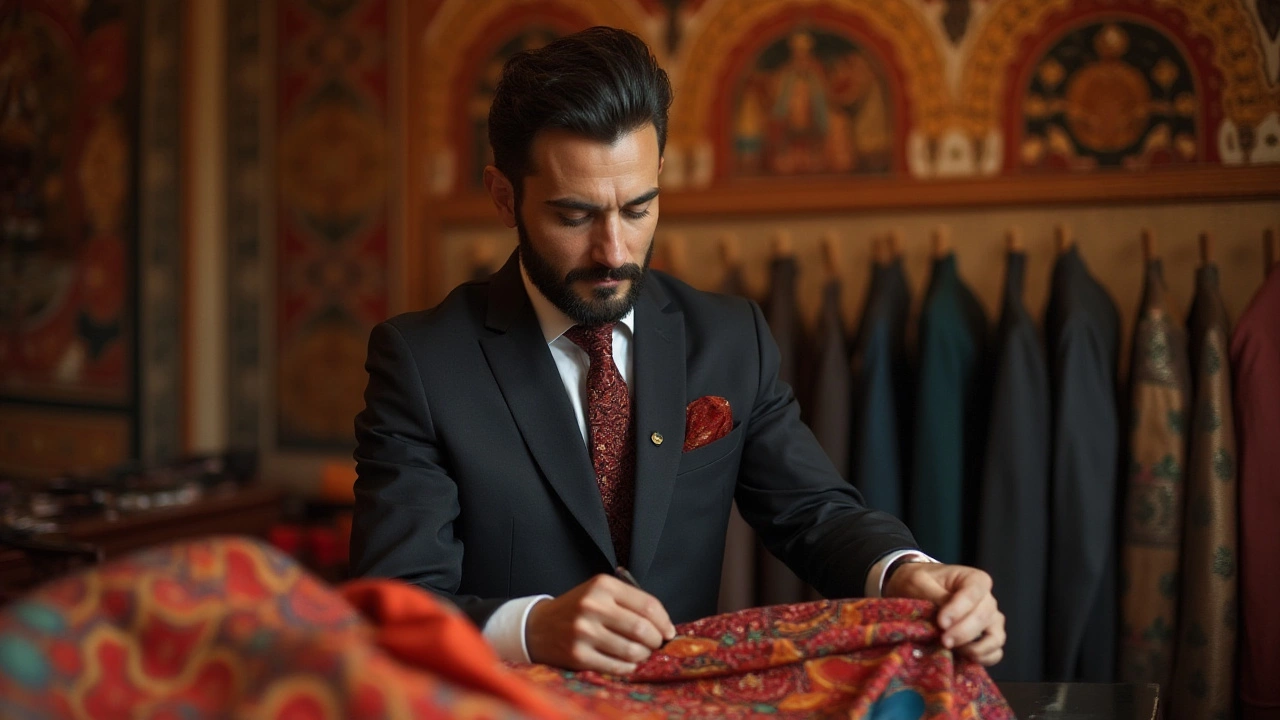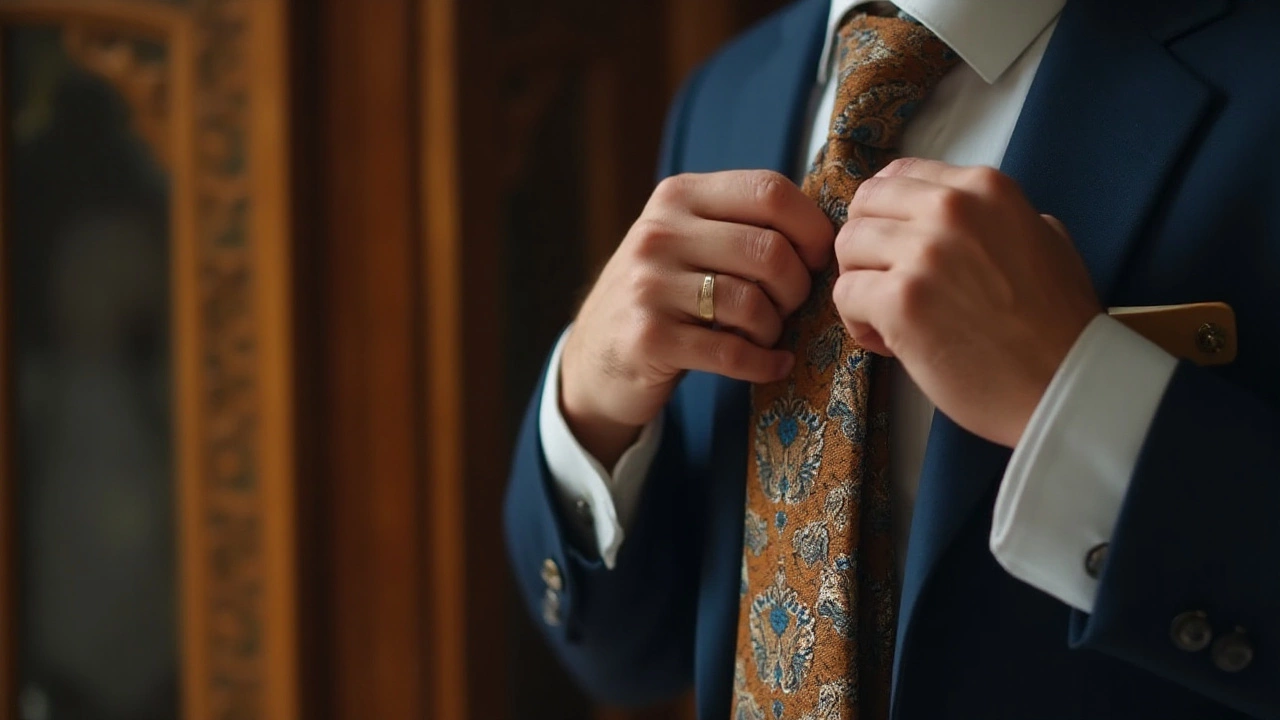How to Identify a High-End Man's Suit

Dressing well is an art form, and nothing encapsulates this more than a perfectly tailored suit. For those who appreciate the elegance of men's fashion, knowing how to distinguish an expensive suit from a run-of-the-mill one is essential. But what exactly makes a suit expensive? Is it the brand, the fabric, the fit?
This journey into the world of high-end men's suits will unravel the mysteries surrounding their quality. From fabric choices to craftsmanship, we'll explore the telltale signs of luxury. Whether you're investing in your wardrobe or simply curious, understanding these nuances will arm you with the knowledge to spot a suit that truly deserves a place in your closet.
- Recognizing Quality Fabrics
- Craftsmanship and Construction Details
- The Importance of Fit
- Brand Reputation and Heritage
- Unique Design Elements
- Caring for a Luxury Suit
Recognizing Quality Fabrics
When it comes to men's fashion, the essence of an expensive suit often lies in the fabric. The type of cloth used not only affects the overall look but also determines how the suit behaves over time—how it drapes, breathes, and holds up against wrinkles. Wool is the quintessential choice for a high-end suit, offering versatility and the right balance between warmth and elegance. From Merino to cashmere blends, these fabrics are treasured for their natural luster and resilience. Expensive suits often feature wool that has been super-finely woven, categorized by numbers like Super 100s or Super 120s, indicating a finer grade. Fabrics like these are softer to the touch and provide a more luxurious feel.
But wool is just the start. Fabrics such as silk, cashmere, or even mohair can be blended with wool to enhance the luxury factor. A blend not only provides a unique texture but also introduces different properties like sheen or durability. For instance, silk adds a refined shine and softens the fabric, which elevates the quality suits to an unmatched level of sophistication. Cashmere, being one of the most luxurious materials, contributes to a suit's plush feel and supreme comfort. Then there's linen, which, despite its reputation for wrinkling easily, is favored for summer suits due to its lightness and breathability.
"A well-made suit starts with the cut, but it's the fabric that tells you everything you need to know," says master tailor David Reeves, expressing the timeless importance of fabric choice in menswear.
The Finer Details
Fabrics are not just about material; it's also about the weave. High-quality weaves like herringbone, twill, or sharkskin offer not only aesthetic depth but contribute to the garment's durability and flexibility. Herringbone and twill weaves, in particular, are noted for their elegance and ability to add a subtle texture to the suit, enhancing its appeal. Meanwhile, a tighter weave not only ensures longevity but provides a smoother surface which is essential in luxury men's suits for maintaining a crisp appearance. Choosing the right fabric is also about understanding seasonal wearability. Heavier wools are fantastic for colder climates, while lightweight mohair or linen blends make an ideal choice for summer. A savvy apparel enthusiast recognizes that an expensive suit does more than fit well: it responds to the environment, showcases personal style, and promotes comfort year-round.| Fabric Type | Attributes | Best Season |
|---|---|---|
| Wool (Super 100s+) | Soft, warm, breathable | All year round |
| Cashmere | Luxurious, soft, warm | Fall/Winter |
| Silk Blend | Sheeny, smooth, rich feel | Spring/Summer |
| Linen | Light, breathable, casual | Summer |
Another important factor is the fabric’s origin. As with wines, certain regions are famed for producing superior materials. Italian and British mills are particularly renowned, with legacy brands in these regions offering fabrics that are consistently revered in the world of luxury men's fashion. Mills like Vitale Barberis Canonico or Scabal, for instance, symbolize centuries of textile excellence, ensuring the suit not only looks impeccable but also stands the test of time. With a keen eye and informed understanding, recognizing quality fabrics moves from art to science, ensuring each new addition to your wardrobe enhances your style quotient effortlessly.
Craftsmanship and Construction Details
When it comes to discerning a truly expensive suit, craftsmanship serves as a hallmark of quality and sophistication. It all begins in the hands of the tailor, where precise measurements are taken to ensure a flawless fit. A well-crafted suit often requires countless hours of meticulous tailoring, where every stitch is carefully considered. This painstaking process is often what distinguishes a luxury suit from its mass-produced counterparts. A high-end suit typically showcases a full canvas construction. Unlike fused or half-canvas suits, full canvas provides superior shape and durability. The canvas, which is inserted between the fabric and lining, allows the suit to mold to the body over time, offering a personalized fit and enhanced comfort.
Paying attention to the details, such as the stitch density, can reveal a lot about a suit's value. High stitch density indicates better construction, as it means the fabric is less likely to pucker and will maintain its shape for years. The lapel roll is another indicator; in a well-made suit, it will have a gentle, natural curve rather than lying flat.
"Luxury, to me, is not only the execution of a design but also the time and care taken in making each piece," explains Giorgio Armani, underscoring the importance of thoughtful craftsmanship.Hand-sewn buttonholes and pick stitching are often present in expensive suits, exuding an understated elegance that machine stitching can't replicate.
Traditional tailoring houses often adhere to specific sartorial traditions, lending a sense of heritage to an expensive suit. This may include hand-sewn details around the pockets, lapels, and jacket edges. Not just for aesthetics, these details play an important role in longevity and movement right along with thread count, embroidering, and lining material.
The attention to detail extends beyond just visual elements. Consider the functional attributes of vents and buttons. A well-placed double vent allows ease of movement and remains closed when you stand, keeping the lines clean and sharp. Similarly, functioning sleeve buttons—often known as surgeon's cuffs—are a subtle sign of craftsmanship that allows you to roll up your sleeves if needed.
For fashion enthusiasts and meticulous dressers, recognizing these nuances not only informs about the suit's quality, but also helps in making informed decisions when investing in a sophisticated wardrobe. It's not merely about wearing a suit, but experiencing a garment that tells a story of precision and art.

The Importance of Fit
The significance of a well-fitted suit cannot be overstated when it comes to projecting confidence and elegance. Imagine wearing a suit that drapes perfectly along your shoulders, cinches at the waist just right, and provides enough room for movement without sagging. This is the power of fit. A luxury suit is not just about the brand or the fabric; it’s largely defined by its ability to enhance your physique. The slightest misalignment or excess fabric can take away from the charm of even the most expensive suits. Tailoring becomes crucial, especially as mass-produced sizes rarely cater to individual body shapes. A suit that fits well allows for a greater range of motion, ensuring you feel as comfortable as you look stylish, a harmony every well-dressed gentleman strives for. In classic menswear, fit is regarded not just as a tailoring term but as an art that respects the silhouette of the wearer.
Historically, the tradition of bespoke tailoring, which comes from the word “bespeak” meaning to speak for something, has always prioritized individualized fit. This personal approach to suit-making is what sets the most expensive suits apart. Tailors consider every nuance of posture, proportions, and even gait to craft something unique for their clients. Today, even if one opts for off-the-rack options, the magic of tailoring transforms it to seem bespoke. Interestingly, a detailed study by the Manchester Metropolitan University found that professionally tailored garments improve wearer confidence by 20%, emphasizing the psychological benefit of a suit that fits well. This explains why so many choose to invest in the tailoring process, seeing it not as an additional expense but as an investment in self-presentation.
"The fit is the most crucial aspect of a suit; without it, the rest is meaningless," says Alden Lucas, an acclaimed tailor in Savile Row.
The journey to finding the ideal fit often involves understanding various elements — the shoulder line, chest width, sleeve length, and trouser hem. Each of these components plays a vital role. For instance, sleeves that brush the wrist bone present a classic appearance, while ensuring that the shoulder seams align perfectly with the edges of your shoulders can prevent any restrictions in arm movement. For the expensive suits, these details are never overlooked. Another intriguing aspect is the tapering of trousers and the break, which refers to how the trousers meet the shoes. A suit shouldn't drape too long or cut too high; the balance is subtle yet impactful.
Investing in a capable tailor is therefore crucial, someone who understands your personal style while providing expert guidance on enhancing your natural shape. Tailors often offer advice on the choice of inner linings that complement the suit’s fabric, affect the drape, and add comfort, which might not be visible to the naked eye but undeniably impact the fit. Finally, it’s important to remember that your body changes over time, making regular adjustments key to maintaining the right fit. Many who own luxury suits routinely visit their tailors for minor alterations, a habit that ensures their suits always fit impeccably.
Brand Reputation and Heritage
When discussing the allure of luxury suits, the conversation inevitably drifts towards brand reputation and heritage. This isn't just marketing jargon—it's a testament that a brand's past speaks volumes about its present offerings. Brands like Brioni, Kiton, and Zegna have become synonymous with high-end suits primarily because they have cultivated a legacy that intertwines rich history with impeccable quality. These brands have maintained loyalty amongst clients by adhering to traditional tailoring methods passed down through generations, blending them with contemporary designs.
In the realm of fashion, a storied history often means decades, if not centuries, of perfecting a craft. For instance, Brioni, established in Rome during the 1940s, revolutionized the idea of men's fashion by introducing striking patterns and vibrant hues into suits—a daring move at the time. This innovation not only set a precedent but also redefined the luxury landscape. Today, owning a Brioni means more than wearing fine fabric; it signals belonging to a lineage of elegance.
Another exemplary brand is Kiton, whose obsession with the phrase "Il meglio del meglio" - meaning "The best of the best" - reflects their commitment to supreme craft. Established in Naples in 1956, Kiton has since handpicked seasoned tailors who pour over 20 hours into creating a single suit. The result is flawless artistry, a testament to the skill and dedication embedded in their tradition. These suits pamper the wearer with a fit and feel that commercial alternatives can't replicate.
Table: Men's Suits Legacy Leaders
| Brand | Established | Unique Offerings |
|---|---|---|
| Brioni | 1945 | Innovative colors, bold patterns |
| Kiton | 1956 | Hand-stitched, bespoke service |
| Zegna | 1910 | Innovative fabrics, eco-friendly practices |
Zegna, or Ermenegildo Zegna as it's formally known, arguably retains its position at the forefront by constantly innovating its textiles. Founded in 1910, Zegna was known as a pioneer in producing ultra-fine wools. The Italian brand has kept its operations vertically integrated by owning its supply chain, ensuring quality from raw material to finished product. In its enduring quest for innovation, Zegna has also embraced sustainability, ensuring that their eco-conscious clients don't compromise on style.
"A man's suit tells a story as nuanced as the individual who wears it," says Giorgio Armani. This couldn't be truer. A premium tag often includes embedded elements of heritage that infuse even the simplest designs with unparalleled elegance and a narrative richer than the fabrics themselves.
The deeper you delve into the world of luxury menswear, the more conspicuous it becomes that understanding a brand's heritage elevates the shopping experience. These brands have a resolute commitment not just to fashion, but to crafting legacies through every expensive suit they sell. Wearing such a piece isn't just a fashion statement but a pledge to continue a legacy of quality and style that celebrates the past while stepping confidently into the future.

Unique Design Elements
When assessing an expensive suit, it's crucial to look beyond the obvious and delve into the realm of subtle design features that define its uniqueness. High-end suits often embody a harmony of traditional craftsmanship and modern flair, which manifests in details that the untrained eye might overlook. For instance, handmade buttonholes are one of these exquisite elements — each stitch meticulously placed by skilled artisans, demonstrating an unparalleled level of dedication and expertise. This minutiae not only adds functionality but is aesthetically pleasing, signifying the hallmark of luxury.
Luxurious suits also often include functional sleeve buttons. Known as "surgeon's cuffs," these were historically important for medical professionals, allowing them to roll up sleeves without removing their coats. Today, this design element has become a testament to tailored perfection. A distinctive lining, too, can differentiate an upscale suit. More than just an interior finish, the lining features patterns or colors unique to the brand, playing both a practical role in ensuring comfort and an artistic one in expressing individuality.
Looking at the pockets, a welt breast pocket for a pocket square is another sign you might be dealing with a high-quality suit. Designers usually give extra attention to this pocket, making sure it complements the suit's fabric and adds a layer of sophistication. Equally significant are the pick stitching details, which may not be prominent at first glance. This subtle hand-sewn aesthetic touch indicates high craftsmanship, enhancing durability while adding an understated visual appeal.
Another fascinating design element involves lapels. The size and style can speak volumes. Notch lapels are more common, while peak lapels might be seen on formal attires like tuxedos, each serving its purpose and exuding a style statement. Lapel pinholes, shaped into small yet precise openings, often accommodate boutonnieres, denoting that the suit is crafted with attention to the finer things. Brands often put extra effort into such details, ensuring that their garments stand out in a crowded marketplace.
Considering all these unique elements, it is evident why a high-quality suit stands leagues apart. Every deliberate design choice serves a purpose, whether to honor traditional tailoring techniques or to inject a modern twist. These elements make the wearer not just feel good physically but instill a sense of confidence and prestige. It's this intricate balance of form and function that truly defines a luxury garment. As the legendary Giorgio Armani once said,
“The difference between style and fashion is quality.”Understanding these design subtleties allows one not only to appreciate but to discern a Masterpiece among the mundane.
Caring for a Luxury Suit
Owning a luxury suit is more than just a statement of style; it's an investment in personal presentation and confidence. Such an investment demands careful attention and maintenance to ensure its longevity and continued appeal. The first and arguably the most critical step in preserving the condition of a high-end suit is understanding the fabric it is made from. Whether it’s fine wool, silk, cashmere, or a blend, each fabric requires a unique approach to care. For instance, wool suits should be allowed to breathe, meaning they should rest on a sturdy hanger to maintain shape and be rotated out rather than worn frequently. Such habits help prevent the fibers from wearing thin too soon. It’s also advisable to avoid direct exposure to sunlight, which can bleach the fabric and alter its color over time, detracting from the sophisticated ethos often associated with men’s suits.
Another paramount aspect of luxury suit maintenance is the cleaning routine. Dry cleaning is recommended, but not excessively, as chemicals involved can degrade fabric integrity. A prudent practice is to spot clean minor stains and brush off any dirt after each wear with a soft-bristled brush. Such measures help in preserving both texture and color, ensuring your suit remains in stellar condition. When it does come time for dry cleaning, discussing specific instructions with the cleaner can prevent potential mishaps. As noted by renowned fashion consultant, Tim Gunn, "A proper cleaning regimen isn't just about removing stains; it's about trusting your suit to the right hands and techniques."
Maintaining the structure and appeal of a suit involves more than just cleaning; it’s about routine care and proper storage.
Proper storage can vastly extend the life of luxury suits. This means using wide wooden hangers to support shoulder structures and covering the suit with a breathable garment bag if it's stored for long durations. It's also advisable to keep suits away from fabrics that might snag or discolor them. While storage away from pests such as moths is vital, using non-chemical deterrents like cedar blocks can protect without compromising the suit's fabric and smell. Furthermore, ensuring there is sufficient space between hanging suits prevents creasing and dust accumulation, two factors that can quickly diminish the suit's refined appearance.
If a suit has been worn for an extended period, allowing it time out of the closet between wears can restore fabric resilience and drape. Humidity and temperature control also play a significant role, helping the suit to maintain its shape and texture. Consider airing it out by putting it in a room with a gentle flow of clean air. For stubborn wrinkles that occur over time, lightly steaming may be necessary, but it's crucial to maintain a reasonable distance to avoid fabric damage. Such nuanced care accounts for why many choose to entrust their exquisite garment's upkeep to professional services, but understanding these basic tips, even at a fundamental level, can make an appreciable difference in its upkeep.